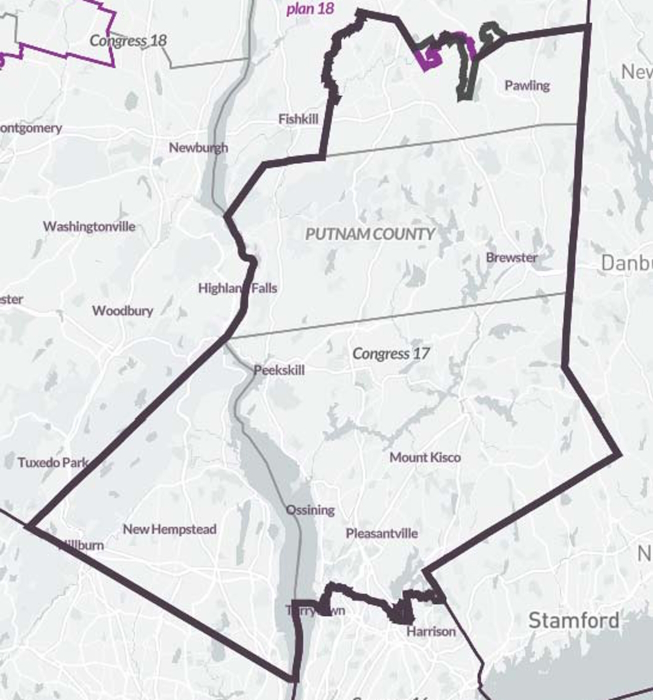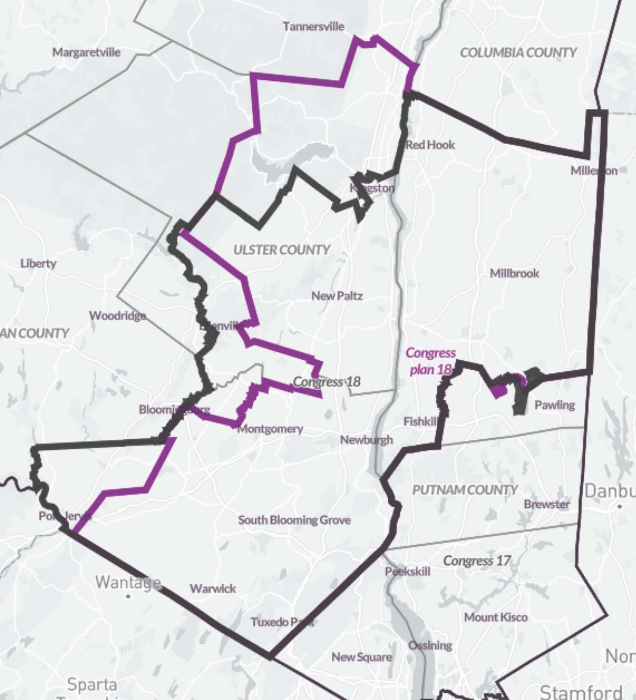State legislature must approve changes
Mike Lawler’s path to re-election will not be any worse and Pat Ryan’s may be easier under redrawn boundaries for New York’s congressional seats sent to the state Legislature on Feb. 16 for its consideration.
The bipartisan Independent Redistricting Commission (IRC) voted 9-1 to approve the maps, which outline the boundaries of the state’s 26 U.S. House districts, but the state Legislature has the final say. The seats include District 17, which includes Philipstown and is represented by Lawler, a Republican; and District 18, which contains Beacon and is represented by Ryan, a Democrat.
The state Legislature could either approve the maps or reject them and draw its own.
Under the proposed changes, District 17 would remain largely as it was when Lawler narrowly defeated five-term Democratic Rep. Sean Patrick Maloney in 2022. The IRC altered slightly the district’s northern boundary in Dutchess County, removing Green Haven Correctional Facility in Stormville and adding additional parts of the Town of Beekman.

The changes likely would not have altered how the district voted for governor and president, according to Redistricting & You (redistrictingandyou.org), a site created by the Center for Urban Research at City University of New York: Voters slightly favored the Republican gubernatorial candidate, Lee Zeldin, over Kathy Hochul, while Joe Biden, the Democratic presidential candidate, easily defeated Donald Trump.
The impact of the changes would be more palpable in District 18, where Ryan is being challenged by Republicans Alison Esposito and Lovelynn Gwinn. The district would become bluer, with the IRC excising parts of conservative-leaning western Orange and Ulster counties and adding Saugerties, Woodstock and other Democrat-leaning parts of northern Ulster County.
According to Redistricting & You, while Zeldin defeated Hochul by 2.6 percentage points in the 18th District in 2022, she would have narrowly won if the new boundaries had been in place. Biden’s share of votes would have increased from 54.2 percent to 55.7 percent in the redrawn district.

If approved, the boundaries would replace ones drawn by a court-appointed expert for the 2022 elections after the IRC commissioners failed to agree and maps created by the Legislature’s Democratic majority for the U.S. House and state Senate were ruled to be an unconstitutional gerrymander.
The state’s highest court, the Court of Appeals, which struck down the Democrats’ maps in 2022, ruled in December that the boundaries used in that year’s elections for Congress were valid for one-time use only, rather than through 2030, when the next federal census is conducted.
The court gave the IRC until Feb. 28 to create new maps for this year’s congressional primary and general elections.
Lawler, whose seat is one that Democrats are hoping to flip this year, criticized the December order by the Court of Appeals as “politically motivated”; the 2022 maps helped him and three other Republicans win seats previously held by Democrats.
On Feb. 16, Lawler urged state legislators to “swiftly” approve the proposed maps. “Any effort to alter these maps should be viewed as another attempt at a partisan gerrymander and should be rejected writ large,” said Lawler, who is facing a challenge from former Rep. Mondaire Jones.
Allowed to stand from 2022 are new maps for the 63 state Senate seats. Rob Rolison, a Republican who represents District 39, which includes Beacon and Philipstown, is facing a challenge from Yvette Valdés Smith, a Dutchess County legislator who represents parts of Beacon and Fishkill and serves as minority leader for the Democrats.


So, redistricting only serves to benefit the person running for office, or already in office, or the party, and not the people? I do not believe that the districts should be allowed to be “redistricted.”
Your article presents a well written analysis of redistricting, including that it does not make Lawler’s re-election more difficult, and that the changes made are unlikely to affect the outcome. Your headline, however, leaves the facts behind and states that “Redistricting Benefits Lawler.” Perhaps there are facts to justify this headline but nothing in the article supports it. Based on the facts that are in evidence this headline is fictional and misleading.
Lawler defeated a five-term Democratic incumbent by 3,200 votes among more than 278,000 cast. Anything less than a dramatic change in the boundaries is to his benefit, which is likely why he called on the state Legislature to immediately approve the revision and complimented lawmakers when they made only minor changes.